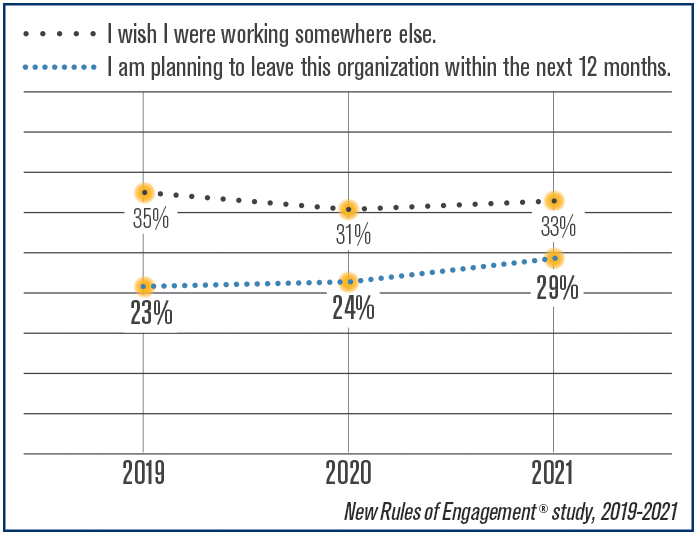Why you need a culture reset in 2022
Feb 01, 2022
Written by: Brad Shuck, Ph. D., Professor of Human Resources and Organizational Development, University of Louisville, Co-Founder, OrgVitals; and Amy Stern, Managing Director, Research and Strategy, BI WORLDWIDE
(View Author Bio)
There are uncontrollable factors contributing to the state of the workforce right now, but for employees who are deciding what's important for their future, learn how we can control the culture we create and become a place employees choose to stay.
Scroll Down
__________
In November of 2021, 4.5 million people voluntarily walked away from their jobs.
__________
The enormity of that number and what that means for the companies and teams they left behind has leaders everywhere taking pause to consider what’s next.
When it comes to the way people work, and the way they think about work, almost everything has changed. In what we’ve now come to know as the Great Resignation, employees are making decisions about their jobs by asking: “What is the cost for me to do this job? Is the cost worth it?” As we’re seeing by the staggering voluntary quit rates, many are concluding their current job is just not worth compromising things like their health, relationships and happiness.
As researchers, it was our natural instinct to try and figure out why people are leaving in record numbers – and what company leaders can do about it. In looking at the data we’ve collected, nothing about work has gotten dramatically worse since 2019. The problems that were there before still exist. But what we found is a significant difference in people’s intent to leave. We asked two questions:
1) Do you wish you were working somewhere else?
2) Are you planning to leave your organization within the next 12 months?
While people’s desire to leave has stayed relatively stable (about 1 in 3 employees), their level of intent and willingness to take action increased in 2021.

Throughout the pandemic, many employees rearranged their lives to accommodate new and different ways of working and now realize their lives, and the way work fits into them, can be changed indefinitely. Other workers – in industries like healthcare, education and manufacturing, to name a few – have been put in impossible situations. The strain on those workers continues to be so great that “burned out” doesn’t even begin to describe it.
But what has become universally apparent is the one underlying factor that either keeps employees around or gives them the push to leave:
Culture.
In fact, 51% of people cited culture as the primary reason for leaving their company.
The culture you create for employees is a differentiator in so many ways. Employees are now looking at work in terms of how it fits into their lifestyle, instead of how their life fits around their work. If they are in the segment of employees who have gone from wishing they work somewhere else to actually intending to leave, the first thing they’ll look at is the culture they experience on a day-to-day basis – and decide if it’s worth it to stick around. (Here’s our approach on what it takes to create a meaningful work culture.)
Use these three steps to evaluate and reset your culture:
1. Understand:
Gather feedback from all levels of your organization, from top leaders to front-line employees and even alumni or potential candidates. This first step will help you understand how people perceive your culture now and what gaps you may need to fill to meet evolving worker expectations.
2. Design:
Once you know where you stand, you can adjust and strengthen your employee value proposition to better reflect where you’d like to go. This strategic phase allows you to carefully define what makes your culture unique, choosing words, phrases, visuals and experiences that you will use to communicate both internally and externally. In short, it’s your way of saying: “This is what it’s like to work here.”
3. Activate:
Bring your culture to life in every touchpoint employees have with your brand. From the moment a potential candidate starts to consider your company, to how they’re welcomed leading up to and on their first day, to what they experience at work on a daily basis and how they are celebrated for big accomplishments and milestones – all of this contributes to creating a culture that will attract and retain employees.
There are uncontrollable factors contributing to the state of the workforce right now. We knew going into 2020 that there’d be a labor shortage due to the Boomer population reaching age of retirement (though this was dramatically accelerated by the pandemic). We’re also seeing low-wage earners being able to make ends meet with one higher-paying job where they used to have to work two or three jobs to get by. But for the remainder of employees, who are deciding what’s important for their future, we can control the culture we create and become a place employees choose to stay.
The best way to get started is to get in touch.



















